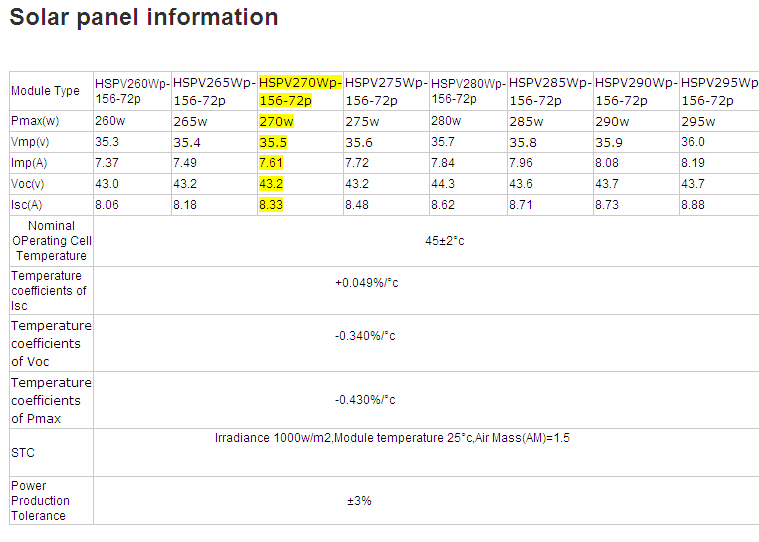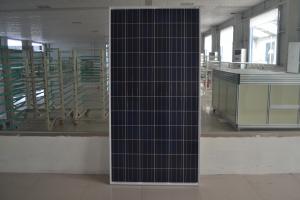Hilight-solar, are pv panel manufacturer in china with TUV,IEC,CEC
OKorder Service Pledge
Quality Product, Order Online Tracking, Timely Delivery
OKorder Financial Service
Credit Rating, Credit Services, Credit Purchasing
You Might Also Like

- Q:In terms of efficiency and cost, what is the best solar panel. I am limited in the number of panels I can put up (probably 6-8) so they must be efficient, but cost is important also.What about these panels that can collect a wider range of light frequency?
- You have to decide which is more important to you, cost or efficiency. The most efficient solar panels that are commercially available cost more than twice as much per square foot than the cheapest ones. Ultimately, I believe that the cost per watt was actually better on the cheaper, least efficient panels, but then you need a lot of square footage in order to generate any substantial power. So it comes down to what you have more of, space or money. The new panels that collect a wider range of light are not currently available commercially, and when they are I am sure that they will be expensive. I have read the research but have not heard of anyone mass producing them yet.
- Q:Alright my family and i are buying a new home in Bradford,Ontario, we we thinking about solar panels and had a couple questions:. how much are they each?2. how many will we need to power a single family home(4 ppl)3. where can we find them in ontario?4.how much money do they really save you?5.what kind of energy do they providfe you withand other basic info or a website i can check out would be great!thanks in advance!
- I have a system that was installed last year. I have 20 panels which provide me with about 75% of my electricity. I do use less electricity than the average home. I use an average of 45 kwh in the summer, my neighbor uses more than double that. I paid $26K for the system, but I got a $0K rebate from my utility and the US gives a fed. tax credit. I am saving about $2K per year, so it will take just over 6 years to break even. I also have what I think is called net metering, my utility allows my meter to run backwards when I generate more energy than I use, so pretty much the entire time the sun is out in the summer. Having energy efficient appliances, reducing standby energy and using conservative climate control really helps keep my usage down. Weather striping, insulation and clean well maintained systems all help as well.
- Q:I have noticed how solar panels cause a glare. Since I am not around solar panels all the time I relate it to when the sun reflects off another car and right into my eyes. So I always wonder if solar panels effect birds and/or animals due to the glare. If I am wrong and solar panels aren't this bad please tell me.
- My solar panels have provided a home for birds, they nest under them. I don't think we should worry about the glare of a solar panel when it is placed on a building that eliminated the habitat that used to be there. Glare is such a minor issue compared to eliminating food and shelter for many animals.
- Q:right now, you would need a suitable number of solar panels just to power house that can take up a lot of real estate. so my question is, is it feasible to create something that absorbs more of the suns energy like a magnet it would suck it up. the point of doing this would be so that we wouldnt need so much space so many panels just to power home for example.i hope thats coherent.
- No, it's not possible to make solar panels that suck in photons like a magnet. In current physics, the only way to do that would be to make a near-black-hole-like structure that sucks photons in due to its high gravity. Not only would that be prohibitively expensive and currently technologically impossible, it would destroy its surrounding area. Edit: idlenesss - My whole point is that increasing the photons-per-area is currently impossible, and that's what the question was about.
- Q:Can solar panels be used on agricultural land?
- Yes, solar panels can be used on agricultural land. In fact, solar installations on farms and agricultural areas have become increasingly popular due to the dual benefits they offer. They not only generate clean energy but also provide farmers with an additional revenue stream. By utilizing solar panels on their land, farmers can offset their energy costs, reduce their carbon footprint, and contribute to a more sustainable future.
- Q:Basically I need a custom solar panel created. I won't go into detail but the dimensions need to be around 4''x2.5'' and be as thin as possible.
- okorder Other sources available on the first Link also. Wingman
- Q:How much energy can a solar panel generate?
- The amount of energy a solar panel can generate depends on various factors such as its size, efficiency, location, and weather conditions. On average, a standard solar panel can generate between 250 to 400 watts of electricity per hour under ideal conditions. However, it's important to note that energy production may vary throughout the day and across different seasons.
- Q:Can solar panels be installed on community buildings?
- Yes, solar panels can be installed on community buildings. Installing solar panels on community buildings is a popular and effective way to generate clean and renewable energy for the community. It not only helps reduce electricity costs but also contributes to a sustainable and eco-friendly environment.
- Q:i've heard environmentalists like ed begley jr use the phrase quot;peak shaving hourswhen talking about solar energy.what does that phrase mean, please?thank you to all who respond.
- Graminoids are among the most versatile life forms. They became widespread toward the end of the Cretaceous period, and fossilized dinosaur dung (coprolites) have been found containing phytoliths of a variety that include grasses that are related to modern rice and bamboo. Grasses have adapted to conditions in lush rain forests, dry deserts, cold mountains and even intertidal habitats, and are now the most widespread plant type; grass is a valuable source of food and energy for all sorts of wildlife and organics. Graminoids are the dominant vegetation in many habitats, including grassland, salt-marsh, reedswamp and steppes. They also occur as a smaller part of the vegetation in almost every other terrestrial habitat. There are some 3,500 species of graminoids. Many types of animals eat grass as their main source of food, and are called graminivores – these include cattle, sheep, horses, rabbits and many invertebrates, such as grasshoppers and the caterpillars of many brown butterflies. Grasses are also eaten by omnivorous or even occasionally by primarily carnivorous animals. In the study of ecological communities, herbaceous plants are divided into graminoids and forbs, which are herbaceous dicotyledons, mostly with broad leaves.
- Q:What is the working principle of solar panels?
- the inorganic salts such as gallium arsenide Ⅲ-Ⅴ compounds, cadmium sulfide, copper indium selenium and other multi-compounds as the material of the battery;
1. Manufacturer Overview |
|
|---|---|
| Location | |
| Year Established | |
| Annual Output Value | |
| Main Markets | |
| Company Certifications | |
2. Manufacturer Certificates |
|
|---|---|
| a) Certification Name | |
| Range | |
| Reference | |
| Validity Period | |
3. Manufacturer Capability |
|
|---|---|
| a)Trade Capacity | |
| Nearest Port | |
| Export Percentage | |
| No.of Employees in Trade Department | |
| Language Spoken: | |
| b)Factory Information | |
| Factory Size: | |
| No. of Production Lines | |
| Contract Manufacturing | |
| Product Price Range | |
Send your message to us
Hilight-solar, are pv panel manufacturer in china with TUV,IEC,CEC
OKorder Service Pledge
Quality Product, Order Online Tracking, Timely Delivery
OKorder Financial Service
Credit Rating, Credit Services, Credit Purchasing
Similar products
New products
Hot products
Related keywords



























